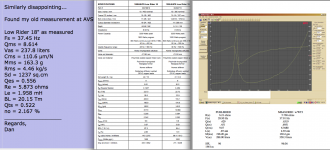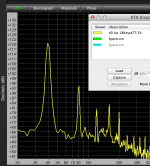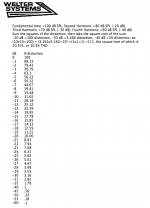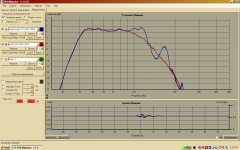Hi tralfaz,
If you have the chance could you measure the TSP's for the Lowrider with REW? I measured one many moons ago and was very disappointed by the results. Hopefully they have brought them back to spec.
Well...........I finally got some kinda impedance measurement with REW ( usually use WT3) but try as I might, I can't get any TS data outa REW and my little rig.
Either I messed up the connections or my M-Audio Mobile Pre does not like having the headphone out driving a speaker and looping back.
For starters, when I check levels befor attempting to measure imp they always show WAY low! But if I ignore that and measure anyway - they show way hot !!
Followed impedance measurement diagram in REW help section.... with Right channels selected in prefs....but measurement only even sorta works if I select left channels ????
And unless volume settings between left and right input channels are identical it wont work. If one is set higher and one lower for example, the impedance measurement goes whack telling me driver is nominal 100+ ohms ???
Finally entered two POSSIBLE imp measurements - one with a mass - and REW refuses to even calculate !
Oy vey....back to cab construction.
Headphone outputs usually have series resistors in line to protect the amplifier from short circuits.Either I messed up the connections or my M-Audio Mobile Pre does not like having the headphone out driving a speaker and looping back.
If one is set higher and one lower for example, the impedance measurement goes whack telling me driver is nominal 100+ ohms ???
Hi tralfaz,
If you have the chance could you measure the TSP's for the Lowrider with REW? I measured one many moons ago and was very disappointed by the results. Hopefully they have brought them back to spec.
Could not get REW / TS to play nice w/my set up. Got this from WT3. What do you think?
Attachments
Could not get REW / TS to play nice w/my set up. Got this from WT3. What do you think?
Similarly disappointing...
Found my old measurement at AVS - thanks Google 😀
Low Rider 18" as measured
Fs = 37.45 Hz
Qms = 8.614
Vas = 237.8 liters
Cms = 110.6 µm/N
Mms = 163.3 g
Rms = 4.46 kg/s
Sd = 1237 sq.cm
Qes = 0.556
Re = 5.873 ohms
Le = 1.958 mH
BL = 20.15 Tm
Qts = 0.522
no = 2.167 %
There appears to be more than one iteration of the "Low Rider", note that the published figures I have below are not the same as yours, and Dan and your measured results are also different.Could not get REW / TS to play nice w/my set up. Got this from WT3. What do you think?
Attachments
There appears to be more than one iteration of the "Low Rider", note that the published figures I have below are not the same as yours, and Dan and your measured results are also different.
More than one iteration of crap is still crappy, time for potty training at Peavey... 😀
More than one iteration of crap is still crappy, time for potty training at Peavey... 😀
I do not know how to evaluate this driver just from the specs. 😕
What are the numbers showing you that shouts crap ? How would you predict it will perform in the Keystone ?
Do you think the LR18 is bad even for a < 200$ driver ? What else is out there that at a value price that would be way better ?
If I accomplish my goal of increased amount of useful bass - with my same power amps - 4 Keystones compared to the 2 dual 18 cabs that the Low Riders were in - just for the wood and some build time? - I will call it a win. That and the form factor of the Keystones is perfect for my little setup.
The crappy thing is that they do not sell what's on the spec sheet, people design systems around what's on the data sheet, and worse yet these drivers are made in house.
IMO the reason the driver is in the state it's in is because they have had to toughen up the suspension to keep it from killing itself; the driver I had had a pretty significant suspension preload due to the cone being taller than the space between the surround and spider landings. The driver is not what I would buy for any application where linear excursion is a requirement. If money is the issue, buy one of the recommended drivers now and then the other as the funds allow.
IMO the reason the driver is in the state it's in is because they have had to toughen up the suspension to keep it from killing itself; the driver I had had a pretty significant suspension preload due to the cone being taller than the space between the surround and spider landings. The driver is not what I would buy for any application where linear excursion is a requirement. If money is the issue, buy one of the recommended drivers now and then the other as the funds allow.
The crappy thing is that they do not sell what's on the spec sheet, people design systems around what's on the data sheet, and worse yet these drivers are made in house.
IMO the reason the driver is in the state it's in is because they have had to toughen up the suspension to keep it from killing itself; the driver I had had a pretty significant suspension preload due to the cone being taller than the space between the surround and spider landings. The driver is not what I would buy for any application where linear excursion is a requirement. If money is the issue, buy one of the recommended drivers now and then the other as the funds allow.
+1
A single KS loaded with the recommended B&C driver would probably match or beat the Dual 18s in performance anyways.
Sent from my iPhone using Tapatalk
Tralfaz,If I accomplish my goal of increased amount of useful bass - with my same power amps - 4 Keystones compared to the 2 dual 18 cabs that the Low Riders were in - just for the wood and some build time? - I will call it a win. That and the form factor of the Keystones is perfect for my little setup.
If you can do frequency response comparison testing at both low power and high power between the Keystone and your old dual 18 bass reflex it will be easy to see if you accomplished your goal.
From what you have mentioned already, it appears you have increased the amount of useful bass, it would be definitely interesting to see by how much, using the same power just at or below amp clipping.
Art
Tralfaz,
If you can do frequency response comparison testing at both low power and high power between the Keystone and your old dual 18 bass reflex it will be easy to see if you accomplished your goal. ...............Art
Thinking the same thing..... I will be ready to try in a few days .....as soon as I finish up my second Keystone.
+1
A single KS loaded with the recommended B&C driver would probably match or beat the Dual 18s in performance anyways.
Sent from my iPhone using Tapatalk
No doubt! Thing is, I would have to really up my amp rack to get the benefits.
When I finish my second cab and can compare the new vs. old - apples to apples - perhaps I will have some useful data to share here. My measurement chops are not so great...but I'm learning as I go.
FWIW my subjective listening to my first Keystone w/LR18 tells me I'm getting nearly the output, if not same, with improved fidelity and less distortion. It is a sweet sounding box IMO.
John,FWIW my subjective listening to my first Keystone w/LR18 tells me I'm getting nearly the output, if not same, with improved fidelity and less distortion. It is a sweet sounding box IMO.
It would also be interesting to actually test the distortion too, as I did in post #12, won't require any special test gear. Although the Keystone had around +6 dB more output than a single 18" BR, it also almost doubled distortion using the same drive voltage, though distortion was still pretty low.
Just recalled that the only sine wave testing I did on Low Riders in TH was outdoors with about 5 feet of snow pack, if you do hit them with sine waves, remember 70-80 volts (about 800 watts) is double their AES rating, keep the tests to only a few seconds duration per frequency, and leave time between for cooling.
Art
More detail in the methodology and distortion readings for other speakers can be seen in this thread, page six sums up most of the information:
PSW Sound Reinforcement Forums: LAB Lounge => JBL SRX718 - Basic Distortion Measurements
from post#12...........link not working for me ???
Oh well, nothing lasts forever, even on the interwebs 🙄.from post#12...........link not working for me ???
This link shows many distortion test examples:
http://www.diyaudio.com/forums/subwoofers/191833-push-pull-vs-normal-distortion-compared.html
Distortion testing is easy with some measurement systems, but still can be done the hard way by looking at a sine wave signal and the resultant harmonics on an RTA, subtracting the difference in dB, then calculating the distortion percentage.
For " close enough for rock and roll" purpose I calculate distortion % using the calculator below, the harmonic with the highest level pretty much determines THD, the contributions added by lower level harmonics generally add only a fraction of a percent to the highest harmonic.
In the example below, we can see 80 Hz, (the second harmonic of the test tone) is 94.1 dB, the 40 Hz test tone is 120.5 dB.
120.5-94.1=26.4
Looking at the distortion calculator chart, we round up 26.4 to 27 dB, and see the speaker has around 4.47% distortion. Rounding up insures the contribution of the harmonics of lower SPL level will still be less than the reported figure.
Art
Attachments
The above was wrong, the difference between the fundamental and the loudest harmonic should be rounded down to the nearest whole number, 26.4 to 26, the speaker has around 5% distortion. Rounding down insures the contribution of the harmonics of lower SPL level will still be less than the reported figure.Looking at the distortion calculator chart, we round up 26.4 to 27 dB, and see the speaker has around 4.47% distortion. Rounding up insures the contribution of the harmonics of lower SPL level will still be less than the reported figure.
I hope the more experienced will provide input but I am surprised how well the KS performed as the Low Rider does not sim well at all... This is making me think more about trying the PA465.
John,was approx 1 meter on axis at roughly 95db.
Looks like there is a 45 Hz LP engaged on both tests. The Keystone should go a lot lower.
If that is two Keystones compared to one dual 18 BR, that still is not a good result, unless the 45 Hz LP is masking the Keystone' LF extension, and the BR Fb is upwards of 45-50 Hz.
Were the tests at about 2 volts? Same signal applied to both the Keystones and the BR?
What is the BR cabinet size? Have you checked it's Fb?
Art
John,
Looks like there is a 45 Hz LP engaged on both tests. The Keystone should go a lot lower.
If that is two Keystones compared to one dual 18 BR, that still is not a good result, unless the 45 Hz LP is masking the Keystone' LF extension, and the BR Fb is upwards of 45-50 Hz.
Were the tests at about 2 volts? Same signal applied to both the Keystones and the BR?
What is the BR cabinet size? Have you checked it's Fb?
Art
Same signal - yes. Moved cabs in and out of same test position
2volts? Across amp output? Not sure - what is correct way to measure 2v at output? Pink noise or sine at some freq?
BR cab is 16cuft tuned to 42.5hz. It has a bump at 50hz. Lower tuning smooths out bump but looses power handeling and gives very little lower extension.
AFAIK the only filter used in this A/B test was 3rd order hi cut at 100hz.
Stimulus signal was log sine sweep from 30hz up. Mic at ground plane 4 feet in front of cab. Nearest structures about 15 ft away.
Test equip:
Peavey PVR-1 omni mic, M-Audio MobilePre USB, Peavey Unity 1000 12 ch mixer, Peavey IPR3k power amp, Lenovo Thinkpad laptop, HOLMImpulse software.
- Home
- Loudspeakers
- Subwoofers
- Keystone Sub Using 18, 15, & 12 Inch Speakers



